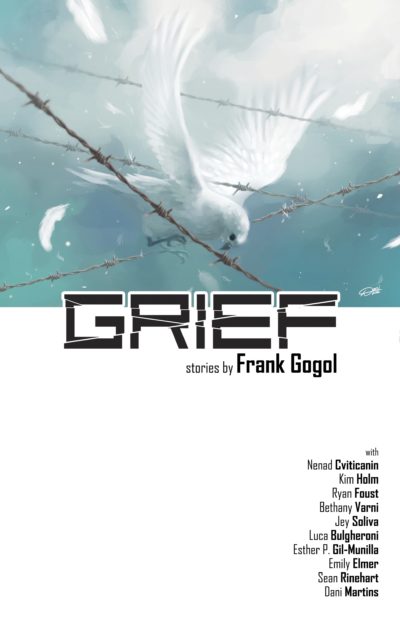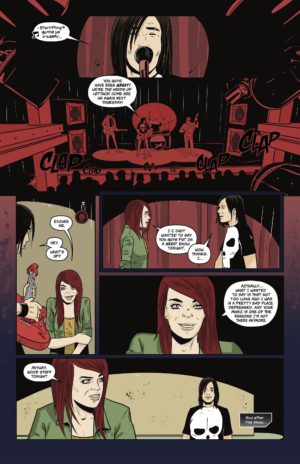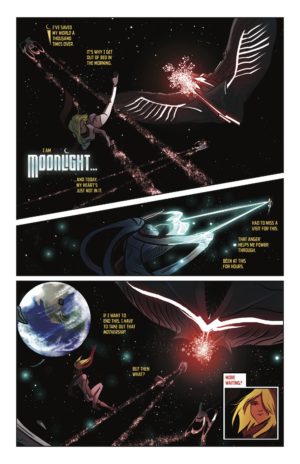Launching today on Kickstarter is a campaign for Grief, an all-original graphic novel about sorrow and loss from writer Frank Gogol and a host of collaborators.
I’ve been lucky in my life to not have to grieve for many people or things I’ve lost for good. From the grief I have experienced, both personally and in supporting my friends, I’ve learned that grief is a permanently ongoing process. It isn’t a single thing or a passing feeling.
If you view it negatively, you could say grief is like a virus that has been introduced into your psyche, one for which there is no cure or permanent recovery. You can ignore it or build up defenses against it, but ultimately you need to experience it to begin to recover.
If you view it as an inevitable part of the human experience, you might instead think of grief like an update to your operating system. Some things will change that you wanted to stay the same. Other things will be streamlined or totally new to you. It will feel alien and miserable at first. Eventually, it will simply be how you operate.
Grief is much more in line with the latter perspective than the former. It’s not a lot of people having nervous breakdowns about how sad they are. It’s about characters coming to terms with a transformed life.
Frank Gogol shared an early copy of Grief with me for review, but the only way for you to get your hands on this comic is to pledge to Kickstarter – a digital copy is just $5!
Want to know more? Keep reading! ![]()
Grief – stories by Frank Gogol (Kickstarter)
![]()
Written and designed by Frank Gogol. Line art by Nenad Cviticanin, Bethany Vani, Ryan Foust, Jey Soliva, and Kim Holm. Colors by Esther Gil-Munilla, Luca Bulgheroni, Nenad Cviticanin, Bethany Vani, and Emily Elmer. Letters by Sean Rinehart. Cover by Dani Martins.
Bottom line: This indie comic anthology themed on grief rarely cries, never preaches, and is surprisingly sparse on treacle. It packs its punch not with heroes (though there are a few) or tear-jerkers (though a few tales come close), but with story after story that squeeze meaningful character moments into just five pages each.
![]()
Grief is an anthology about all kinds of loss, but it’s not a downer. Instead, it’s an introspective look at how grief is a twisting path that can be full of sorrow and loss but also hope and gifts – sometimes both at once.
This series of ten vignettes each have an indie comic look and feel. The characters populate a world adjacent the high-flying, super-powered, magic-wielding heroes we love from glossy superhero comics. For some stories, we’re in the middle of that world, but in others we’re on the margins. Some of the tales could work as introductions to ongoing series, but others are complete and satisfying all on their own.

A page from “Gravity,” with art by Nenad Cviticanin.
Two of the best stories in the anthology, “Gravity” and “The World,” feel like pilots to incredible indie super comics that ought to be. Yet, their narrative punch comes from delivering truth about their characters in a handful of pages, not from big action beats.
By contrast, “Different” and “Highs and Lows” are both self-contained character studies, each about how you can find something new within loss. More pages wouldn’t change their stories – they might even lose their impact if they were longer.
Before I made it that deep into Grief, the first thing that struck me was that it looks like a major publisher comic book.
That’s remarkable.
There are many brilliant authors and artists in the indie crowdfunding world with genius to offer, but being good at their craft doesn’t make them good graphic designers.
We’ve all learned not to judge a book by its cover, but poor choices in colors, fonts, and layouts can kill a project before it ever finds a fanbase. Even many mid-sized comic publishers can’t design an attractive book jacket to save their lives (or businesses).
Grief‘s graphic design (by author Frank Gogol!) is strong, from the stark, shattered logo to the placid blue of the interstitial pages drawn by cover artist Dani Martins. It feels a lot like Jonathan Hickman’s approach to collection design, where even the chapter breaks are part of the story.
Further, the colors across all of the stories range from strong to fantastic. It’s incredibly hard to nail a professional coloring look that will hold up on a shelf or screen against the best of today’s comics – and even harder to do that across multiple colorists in an anthology title. Grief‘s team maintains the quality across the book with little exception. The same is true for Sean Rinehart‘s lettering. Rinehart keeps things easily readable on screen while experimenting with different styles and fonts throughout the book.
Altogether, the choices and the talent behind them screams, “love this book, because we made it with love.”
Primary artist Nenad Cviticanin is responsible for line art on six of the ten stories and color on a half of those. When he’s coloring himself, as on “Cassandra” and “Highs and Lows,” his flat colors and animated faces giving a hint of Mark Waid’s recent run on Daredevil with artists like Marcos Martin and Chris Samnee. He’s also got impressive range – I would have never guessed that he also drew and colored “Gravity”!

A page from “The World,” with art by Bethany Varni.
When Cviticanin is joined by colorist Emily Elmer for “Different,” the results are phenomenal. The art has shades of The Luna Brothers on Alex + Ada, and even the unparalleled Mike and Laura Allred. As amazing as Mike Allred is, much of the dynamic power of his art is down to the heft of Laura’s colors, which add depth and weight to Mike’s simplicity. Elmer’s colors have that same quality, which requires a simplicity of art like Cviticanin’s.
I would totally believe you if you told me it was a lost X-Statix story excerpted from an X-Men anthology about a world that’s full of hate and fear for people who are different.
Four other line artists contribute a story each. A standout in the quartet Bethany Varni on “The World.” She achieves something bold and simple with her images of a spectacular space battle, and she continues that strength in her depiction of the mundane on Earth. I’m definitely interested to see more work from her.
Not every story is a home run. The book has a few somewhat treacly moments you’d expect from its name. A few times I felt it go “full Hallmark” with a well-worn trope.
Yet, that’s coming from me, who hasn’t experienced a lot of this grief first hand. The moments that actually gut-punched me were the ones I could relate to the most. My “treacle” could be your “gut punch.” Your gut punches may vary.
Only once did I feel that the brief story length really got in the way, and it was on what may have been the best story.
“Cassandra” is a masterful balance of narration and narrative, with a policeman remembering myths he read as a child while negotiating the standoff between his partner and a woman who is convinced the man is some sort of alien body-snatcher. I was shocked by where it ended – I expected it to return as a bookend at the end of the book! It’s some of the strongest work here, but it also feels the most incomplete.
A story that makes great use of its brief length is “The Debt.” It’s a tale of a young woman who fights evil as she desperately clings to the normalcy she has in life with her grandmother, even as it decays. With jagged visuals to match the disturbing story, it’s complete all on its own (even though it could easily work as the origin for a longer book). “Heat” and the clever “Gravity” are similar in scope.
“Heat” is unique among these stories in that we see a character actively grieving. He’s in the earliest part of the process, where everything in the world feels like an open wound. Elsewhere, the grief has metastasized for some characters, or become a subtle hum in the background for others.
If there’s a theme to this collection other than the title, it’s that author Frank Gogol is a major storytelling force. The revealing moments of character he’s able to create in these short spans – sometimes entirely without dialog – are magnificent. He also finds a number of unexpected panel layouts along with his artist collaborators. which helps make these stories feel distinct from each other.
If this is what Gogol can do with ten stories in fifty pages, I’m ready to subscribe to whatever he can achieve with his first ongoing comic.
If you’re the kind of comic reader who loves major story arcs, these five-page stories are not going to satisfy you. If you enjoy a short story that can make you think and lets you imagine a greater world extending in either direction from it beginning and end, then you should support this book.
![]()
Review Disclosure: I received early access to this comic so that I could discuss it concurrent with its release. I still paid/donated in exchange for the book upon release. I only effusively praise things that I truly enjoy.
Have an indie comic for me to read, review, and preview? Contact me today!